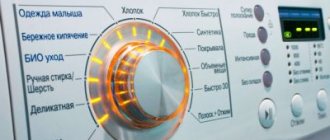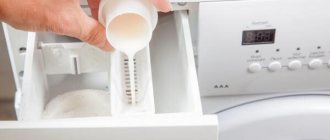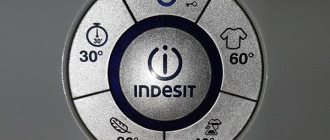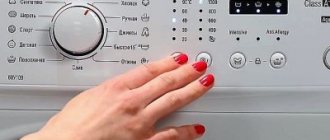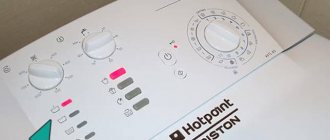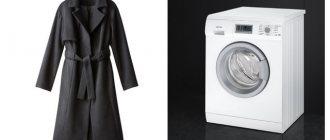Pre-washing in a washing machine - not everyone knows what it is and what the mode is used for. Almost all modern technology models are equipped with this function. In this article we will look at what it is, as well as all its advantages and disadvantages, so that you can decide whether it is worth using.
Why do you need pre-wash?
How to understand what prewash means and why it is needed? In order for the laundry to be washed efficiently, you need to use not only the main program, but also the preliminary one.
Read also: Meaning of the word OU. What is an op-amp?
Some users constantly wash things in fast mode. This is effective for lightly soiled items. But clothes with stains and heavy soiling cannot be washed this way. That's why . You can install it before the main programs:
- Cotton;
- Synthetics;
Similar to regular soaking
Housewives often equate this function to soaking. In reality this is a different procedure. Pre-washing replaces hand-washing clothes .
The mode should be started if the laundry is heavily soiled or there are complex stains on the fabric. For example, activating the option will be justified if the drum is loaded with a work uniform, a tablecloth soiled during a feast, or the pants of a child who fell into a puddle.
The purpose of prewash is not to remove stubborn stains, but to soften them so that the dirt can be washed away during the main cycle.
In fact, there is an effect from the regime, and it is very noticeable. Let's figure out how the machine works during the pre-wash.
Principle of operation
How do you understand the term “Pre-wash”? This means that an additional procedure occurs before the main program. The option can be enabled or disabled as desired. But some modes already involve soaking in a washing machine, for example the “Cotton” program at a water temperature of 90 degrees.
Now let’s figure out what the principle of operation of the pre-mode in a washing machine is:
- You need to pour powder into the detergent compartment for pre-soaking in the washing machine, then select a program;
- Water is drawn into the drum of the machine and heated to 30 degrees. This temperature can remove various stains, including those from fruit or coffee;
- The washing machine draws water from the tray that contains the detergent for soaking. In this case, the powder remains in the main compartment. How much powder should I pour? Fill the compartment exactly as much as the main wash compartment is filled;
- The laundry is cleaned by a drum that rotates slowly;
- We have already looked at how long the pre-wash lasts. Depending on the manufacturer and model of the equipment, the procedure lasts a certain amount of time;
- The water is drained, after which the main wash begins.
In this mode, a compartment is used, which is designated by the Roman or Arabic numeral 1, as well as the letter A. Many people wonder about pre-wash detergent - what is it? For this you can use the same powder as for the main one. But there are also special chemicals for more effective soaking, for example, HG, Crystal or Persil.
What is it and what is it for?
Modern washing machines are equipped with a wide variety of functions. With each new model they are added and improved. The panel displays a bar icon with a bracket at the bottom. Some manufacturers designate the mode with a simple inscription.
Pre-washing in a washing machine – what is it and what is it for? It is used to wash clothes more thoroughly. Usually the mode is turned on along with the main one, so the procedure is of different quality, although it takes longer than usual.
What is the difference between pre-wash and main wash? If things are not very dirty, many people wash the items quickly. This type of washing will not help with stubborn stains. The function is primarily used before the following programs:
- delicate and handmade;
- cotton;
- synthetics;
- baby clothes;
- intense;
- jeans.
Useful: how to wash a faded item at home?
Pre-soaking in a washing machine is not compatible with the fast or express mode. We figured out what pre-washing is in a washing machine. But how does it work? Essentially, the laundry is soaked for a certain amount of time. As you know, quality is affected by several factors: mechanical stress, the chosen product and hot water. The preliminary regime doubles the impact of these factors. And the result cannot be compared with hand washing or only basic washing, this is especially noticeable with heavy soiling.
Soaking in the washing machine takes longer than just the main wash. At the same time, the consumption of water and powder increases. How long does the process take? In general, it can be from 15 minutes to two hours. As a result, in combination with other programs, the entire procedure can take up to 4 hours.
Description of other programs:
- Express;
- Ferry;
How is the washing process?
The program is compatible with a standard set (cotton, linen, wool, synthetics, sports, children's clothing, dark clothes, etc.). Before each of them, you can additionally install a pre-wash. But there is simply no need to combine prewash with daily and express programs, since they are designed for lightly soiled laundry.
This function implies two washes in a row without stopping the machine. Therefore, before the cycle, the powder is poured in immediately for both the preliminary wash and the main wash. To do this, the tray has 2 compartments, each of which must be filled with cleaning agent.
The process goes like this. First, the machine draws clean water and streams powder from the pre-wash compartment. The laundry is in the drum, periodically spinning in a soap solution for the time allotted by the program. At the end of the pre-wash, the dirty water is drained and the laundry is rinsed. The device draws clean water, takes powder from the main compartment, and washing automatically begins according to the standard program.
Symbols of Bosch washing machine modes
Among other things, Bosch washing machines differ in the marking of their controls. For this purpose, symbols (icons) are used. The designations stand out for their originality, which is why users have different attitudes towards them. Some people find icons convenient, others don't.
There are several reasons why the manufacturer preferred drawings on the panel instead of the usual inscriptions:
- minimum space occupied;
- high information content;
- icons are understood by everyone, no language barrier;
- ease of decryption.
Bosch engineers tried to select a picture for each mode that will evoke the desired association and help you quickly find your way around, but at first it’s easy to get confused.
Additional
In addition to the main programs, manufacturers can use additional ones. There are quite a lot of them.
Wool
Not all units are equipped with the “Wool” mode. The cycle is intended for the care of knitted and knitted items. The water warms up to a maximum of +40. There is no rotation of the drum - it simply sways from side to side, simulating working with your hands. When spinning, the minimum speed is automatically used.
Fact! In order not to provoke overload, it is recommended to fill the drum only 2/3 of the total volume.
Sport
The program includes soaking or pre-washing. This ensures maximum cleaning of difficult fabrics such as those used in sportswear.
Shoes
Designed for the care of sneakers and sneakers made from textile fabrics. Cycle duration is up to 50 minutes.
Kids' things
Washing occurs at high temperatures, additional rinsing is provided. Suitable for allergy sufferers, as detergents are washed out as thoroughly as possible.
Night
The quietest program, so you can use it at night. There is no spin and no sound signals.
Volumetric things
Designed taking into account the characteristics of outerwear and other wardrobe items that can absorb large amounts of water. The average cycle duration is 1.5 hours. Suitable for soft toys.
Hypoallergenic
The cycle uses one additional rinse to ensure that the detergent particles are completely washed out of the fabric. The water heats up to +60, so washing delicate fabrics is prohibited.
The mode is quite long and uneconomical, since heating requires more electricity. Water consumption also increases.
Easy ironing
There is no intermediate spin, and the final spin occurs at lower speeds. Rinsing uses a larger volume of water.
Before the end of the cycle, items are steamed, which makes ironing difficult fabrics, such as linen, easier.
Fact! It is recommended to fill the drum to approximately 2/3 of the permissible weight.
What does improper care lead to?
The difficulty in caring for woolen items is due to several factors. Among them:
- yarn sensitivity to high temperatures and temperature changes;
- texture of the material (looseness, peculiarity of the weave of threads, etc.);
- the tendency of wool to deform when wet;
- the ability of the material to absorb a lot of water and release it poorly;
- poor rinsability of wool after soaping;
- significant weight gain as a result of getting wet.
Any violation of the technology of washing, drying and storing items can lead to rapid damage to the product. But with proper care, the item will last for years, keeping you warm and pleasing in appearance.
Product village: is there a way to fix it?
This effect can lead to:
- Wash in hot water.
- Abrupt change from hot water to cold.
- Using the wrong detergent.
- Wash together with items made from rough fabrics, etc.
It is not always possible to restore the shape of a damaged item. Severely shrunken or matted woolen clothing will have to be removed from the wardrobe.
There are several techniques you can use to try to return things to normal. One of them is to wet it without detergent and try to stretch it a little by placing it on a horizontal surface.
Read about how to stretch a shrunken wool sweater here, and about returning the original shape of a wool sweater here.
How to use this option
The use of the function implies a continuous double working process of the machine. Therefore, before starting, the detergent is poured into two sections of the tray at once: for preliminary and main washing.
First, the device draws water and automatically adds powder from the compartment marked 1, I or A. After gently spinning the laundry in a soap solution for a certain time, the machine drains the dirty water and rinses.
The machine then fills the drum with clean water and removes detergent from compartment 2, II or B for the main cycle.
To use the option, the user must:
- load dirty laundry into the drum;
- pour detergent into two sections of the powder receptacle;
- select the desired program;
- Press the “Pre-wash” button.
Expert opinion
I work in the household appliance repair industry. Extensive experience in restoring washing machines and dishwashers.
Ask a Question
This function extends the duration of a standard work program by a period of 15 minutes to several hours.
Algorithm of actions
If there are useless or unnecessary modes or programs in some washing machine models, it is definitely not pre-washing - it is just as important as rinsing or spinning. What the user must do:
- Before turning on the SMA, fill the powder compartment. An additional portion is poured into the second compartment - it is located in the container marked with the number “I”.
- Press the corresponding button on the control panel.
After this, the machine starts working. What's going on in it? Algorithm:
- The machine fills the tank with a lot of water. The heating element heats it up to 30 °C.
- Water is collected, powder is consumed from tray “I”, and remains in tray “II”.
- The drum rotates slowly - the powder gradually dissolves, and the laundry is washed. How long does the process take? The exact time depends on the model and manufacturer of the SMA, on average - two hours.
- The machine drains dirty water and fills it with clean water.
- The drum begins to rotate fully. The powder from the second tray is consumed. Then the program that the user selects is launched - “Cotton”, “Synthetics” or any other.
- Then - rinse, spin. You can run an additional rinse.
Control panel icons
To find out what a particular icon on the control panel means, you can look at the instructions. Manufacturers often write the name of the mode - then no questions arise.
Most models have the same icon indicating pre-washing - W-shaped. This is the icon used in models from Samsung, LG, and Bosch.
Detailed feature overview
Pre-wash is an additional function that can only be used with some washing modes. The main modes in most machines are as follows:
- Cotton and linen washing program
- Synthetic fabric washing program
- "Gentle wash"
- Washing program for wool items
- "Handwash"
Some machines have programs for washing curtains, sports shoes, children's clothes, dark clothes, jeans, etc. The pre-wash function is available in most cases when you turn on the washing modes for cotton and linen, synthetics and other modes in which washing takes a long time. The total time can increase to four hours on the longest modes.
The Pre-Wash button is located on the panel next to the other buttons. Before pressing it, you need to pour the washing powder into a special compartment; it can be located to the left or right of the central compartment.
Since the main wash begins immediately after the preliminary wash is completed, the powder must be poured into two compartments at once. The amount of powder is indicated in the instructions for the washing machine.
When using a pre-wash, it is more convenient to use powder, since the liquid detergent will quickly flow down, and when the main wash begins, it will proceed without detergent.
Tips and tricks
We figured out what pre-washing in a washing machine means, but even it can’t always save a thing if you don’t follow some simple rules:
- To better understand why you need and how to use automatic pre-wash in a machine, carefully read the instructions for your household appliances. Each model has its own nuances and features.
- To prevent things from fading or staining, be sure to sort them by color and type of fabric.
- Do not store contaminated clothing for too long. The longer it sits, the more the stain is absorbed.
- Before washing items in a machine, treat areas with difficult-to-remove special products or improvised components.
- In order not to spoil not only things, but also the machine itself, choose the right detergents.
Now you know how to turn on and why you need the pre-soak mode in your washing machine. The program can help in difficult situations when the usual method cannot cope with certain types of pollution. This is due to additional mechanical stress, time and hot water. We will talk about how often you need to wash curtains below.
Does she always help?
If things are covered with stains that are difficult to remove, then even “soaking” in SMA will not help remove them. Often the users themselves are to blame for this. How to avoid problems:
- Do not stack laundry with different levels of soiling together. Dirtier products will stain the “neighbors.” Colored laundry may fade due to close contact and high humidity.
- Do your laundry weekly—don't hoard dirty laundry.
- Treat items with stains. Remove dirt. If this is not done, then the stains after contact with heated water will become even stronger in the fabric fibers.

